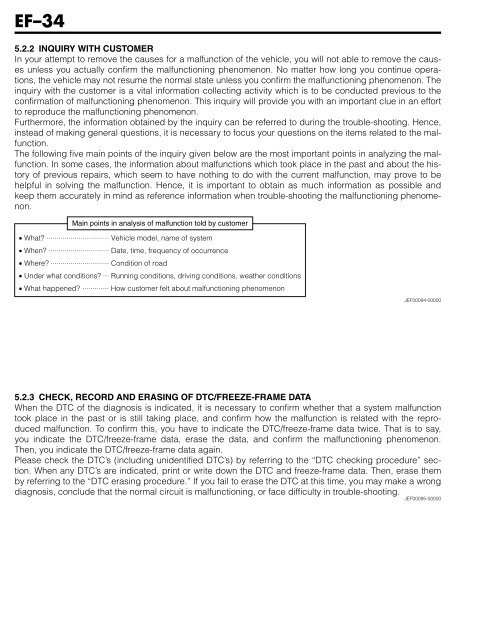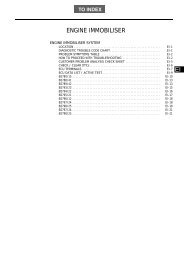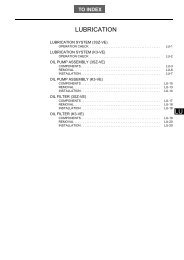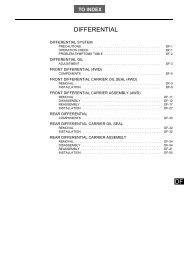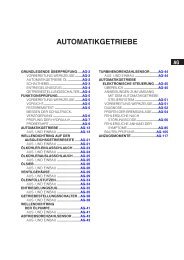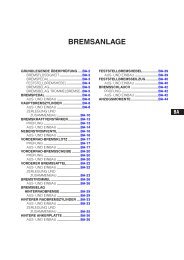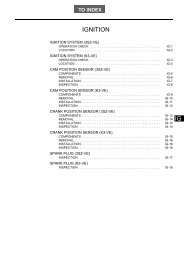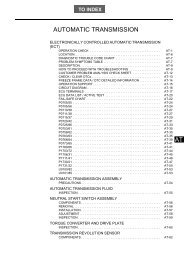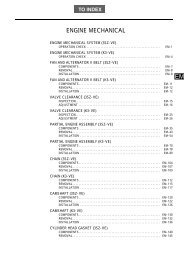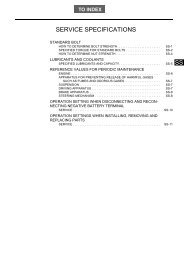EFI SYSTEM
EFI SYSTEM
EFI SYSTEM
- No tags were found...
Create successful ePaper yourself
Turn your PDF publications into a flip-book with our unique Google optimized e-Paper software.
EF–34<br />
5.2.2 INQUIRY WITH CUSTOMER<br />
In your attempt to remove the causes for a malfunction of the vehicle, you will not able to remove the causes<br />
unless you actually confirm the malfunctioning phenomenon. No matter how long you continue operations,<br />
the vehicle may not resume the normal state unless you confirm the malfunctioning phenomenon. The<br />
inquiry with the customer is a vital information collecting activity which is to be conducted previous to the<br />
confirmation of malfunctioning phenomenon. This inquiry will provide you with an important clue in an effort<br />
to reproduce the malfunctioning phenomenon.<br />
Furthermore, the information obtained by the inquiry can be referred to during the trouble-shooting. Hence,<br />
instead of making general questions, it is necessary to focus your questions on the items related to the malfunction.<br />
The following five main points of the inquiry given below are the most important points in analyzing the malfunction.<br />
In some cases, the information about malfunctions which took place in the past and about the history<br />
of previous repairs, which seem to have nothing to do with the current malfunction, may prove to be<br />
helpful in solving the malfunction. Hence, it is important to obtain as much information as possible and<br />
keep them accurately in mind as reference information when trouble-shooting the malfunctioning phenomenon.<br />
Main points in analysis of malfunction told by customer<br />
• What ............................... Vehicle model, name of system<br />
• When .............................. Date, time, frequency of occurrence<br />
• Where ............................. Condition of road<br />
• Under what conditions ... Running conditions, driving conditions, weather conditions<br />
• What happened ............. How customer felt about malfunctioning phenomenon<br />
JEF00094-00000<br />
5.2.3 CHECK, RECORD AND ERASING OF DTC/FREEZE-FRAME DATA<br />
When the DTC of the diagnosis is indicated, it is necessary to confirm whether that a system malfunction<br />
took place in the past or is still taking place, and confirm how the malfunction is related with the reproduced<br />
malfunction. To confirm this, you have to indicate the DTC/freeze-frame data twice. That is to say,<br />
you indicate the DTC/freeze-frame data, erase the data, and confirm the malfunctioning phenomenon.<br />
Then, you indicate the DTC/freeze-frame data again.<br />
Please check the DTC’s (including unidentified DTC’s) by referring to the “DTC checking procedure” section.<br />
When any DTC’s are indicated, print or write down the DTC and freeze-frame data. Then, erase them<br />
by referring to the “DTC erasing procedure.” If you fail to erase the DTC at this time, you may make a wrong<br />
diagnosis, conclude that the normal circuit is malfunctioning, or face difficulty in trouble-shooting.<br />
JEF00095-00000


